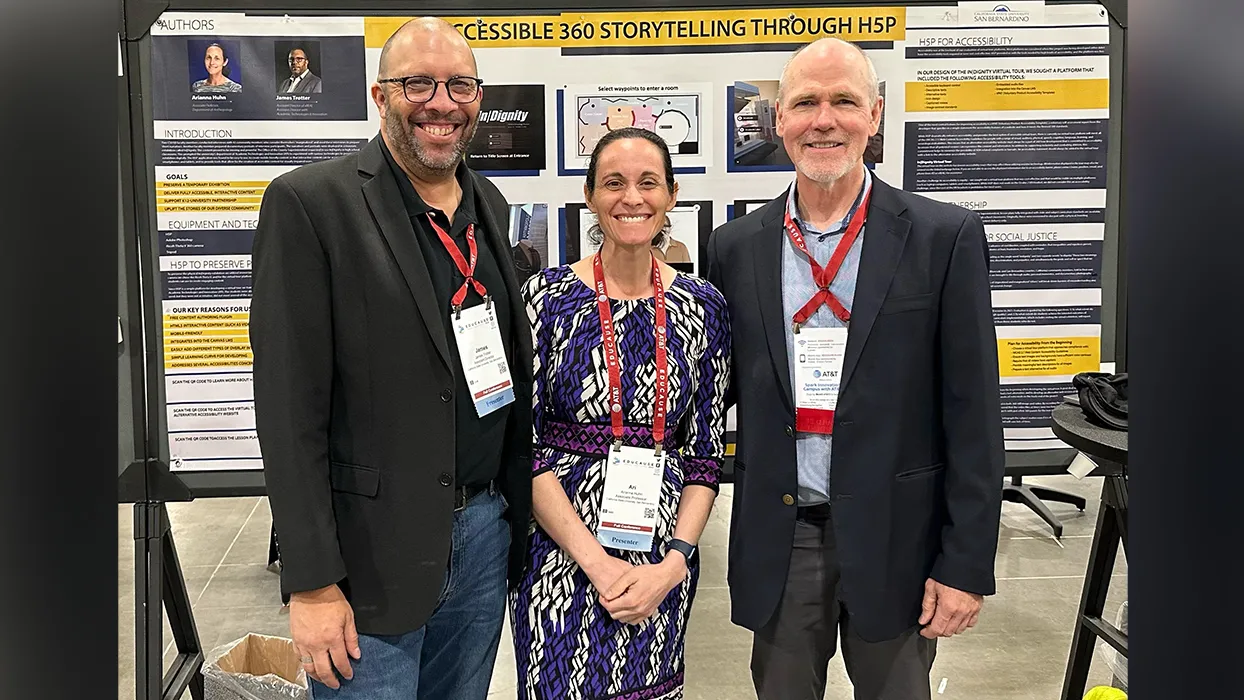Joe Gutierrez | Office of Strategic Communication | (909) 537-3007 | joeg@csusb.edu

Efforts to preserve a Cal State San Bernardino department museum project using a 360-degree virtual tour was the focus of a recent poster presentation by Arianna Huhn, an associate professor of anthropology, and James Trotter, assistant director of Academic Technologies & Innovation (ATI).
The poster presentation of “Accessible 360 Storytelling through H5P” at the EDUCAUSE Annual Conference last month highlighted the university’s work to continue its In|Dignity exhibition long after the exhibit ends.
Huhn said through the poster, they were able to share with educators from across the world a CSUSB project to develop an immersive, virtual tour of the exhibit, which she and Annika Anderson, an associate professor of sociology, curated in 2018.
The In|Dignity “project was so important to preserve because it shares the stories of community members, in their own words and each with stories that help everyone to recognize the diversity of the Inland Empire, as well as our shared humanity. The exhibit touched a lot of lives in its physical form.”
“But all exhibits have to close eventually. This project allows In|Dignity to live on, to be incorporated into K12 classrooms through a partnership with the Office of the Superintendent of San Bernardino County (which created lesson plans that anyone can use), and to continue to help people to challenge their stereotypes about their neighbors, family and friends,” Huhn said. “That the virtual tour is also now out there in the world serving as a model of accessibility further supports the show’s original mission.”
The efforts to preserve a museum exhibition involving text, objects, audio and images became a testing ground for creating accessible 360 tours. Through experimentation, H5P (short for HTML5 Package, a free and open-source content collaboration framework, which enables educators to create content such as interactive videos, quizzes and presentations) was identified as the most user- and disability-friendly option. The modular learning platform and content management system links 360 (equirectangular) images into environments that users navigate within or between amid interactive elements such as explanations, videos, audio and images, with optional assessment tools.
The poster generated a lot of interest, with many conference attendees asking questions about the logistics of setting up accessible 360 tours in H5P, said Huhn, who added that the “problem-solving that ATI staff and student assistants worked through to develop this project is really a model for virtual tours that are built from the beginning to be accessible.”
“Attendees also asked about the nature of collaborations between Information Technology Services and faculty. I hadn’t realized how unique our IT-faculty partnership model is at CSUSB,” Huhn said.
Trotter added that at the start of a project it was vital that immersive media content such as extended reality (XR) be a consideration, which he talked about at the conference.
‘It is critically important that we develop immersive media content and make accessibility a priority from the beginning of project development,” Trotter said. “Accessibility for XR media content was a very important topic of discussion that I have with several institutions at Educause.”
About xREAL: Extended Reality for Learning (xREAL) Lab with Information Technology Services (ITS) at CSUSB is an interdisciplinary technology innovation hub that brings together faculty, students, and staff to imagine and design immersive learning experiences with 3D modeling and printing, augmented reality, mixed reality, virtual reality, motion caption, and machine learning technologies. Each year, xREAL works with faculty fellows and undergraduate and graduate students across disciplines to provide a vision for future teaching and learning, mentorship and hands-on experience for the students, and sustainable innovation for the larger campus community. xREAL work is made possible thanks to generous support from President Tomás D. Morales and Vice President for Information for Technology Services Sam Sudhakar.